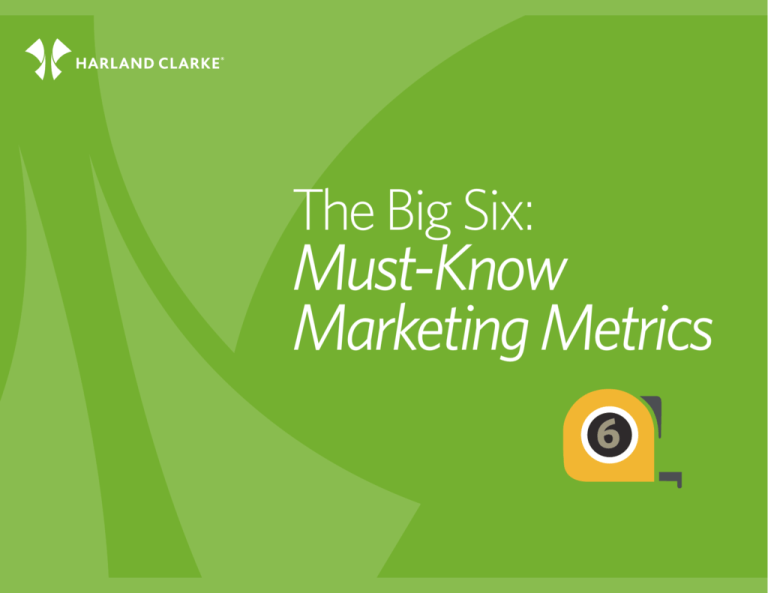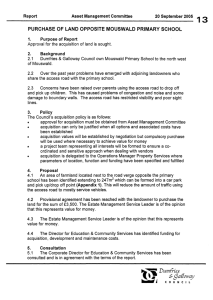
The Big Six:
Must-Know
Marketing Metrics
6
As a financial services marketer, your job
is evolving. You are being asked to do more,
contribute more, and prove your value.
Expectations are high that your efforts will go
far beyond tactical marketing initiatives to truly
help your organization reach its strategic goals.
Savvy marketers today must not only plan and implement
marketing campaigns — they must also measure the effectiveness
of their efforts. With that in mind, we offer six metrics that we
believe financial services marketers must embrace to drive
performance.
Propensity to Buy
As a marketer, it’s critically important to know where to spend your
hard-won marketing dollars. Understanding your account holders’
and prospects’ propensity to buy certain products and services can
go a long way toward improving the effectiveness of your marketing
spend. This in turn ensures the best return on your marketing
investment.
Marrying your institution’s own data with purchase potential
models lets you quickly assess which account holders and
prospects have the highest propensity to buy a specific product or
service. Similarly, a “next-most-likely” product model can tell you
the “next” product or service they are likely to purchase.
With this information, you can focus acquisition and cross-sell
initiatives on offering only those products and services your target
audiences are most likely to buy. As such, you can expect a better
response rate and greater return on your marketing investment.
Cost per Acquisition
Cost per acquisition is a key measure of the impact of your
acquisition programs. Getting to this number is easy: Simply divide
your acquisition costs by the number of accounts generated. But
don’t stop there. You’ll also want to know 1) how your cost per
acquisition compares to peers; and 2) how profitable the acquired
accounts are.
There are a number of industry associations and financial services
firms that can help you see how your cost per acquisition stacks up.
Determining account profitability will require a conversation with
your chief financial officer (CFO) to quantify the value of the
accounts generated. For example, say it costs you $1,000 to acquire
2
a new $500,000 mortgage. What is your institution doing with
that mortgage — selling it or servicing it? If the former, what’s
the sales commission your institution earned and what’s your net
profit? If the latter, how long will the mortgage likely stay on your
books, and can you use your net interest margin to determine the
year-to-year value of that mortgage?
Knowing your cost per acquisition — along with the profit you’re
generating for your institution — is how you prove marketing value.
Loan-to-Deposit/Loan-to-Share Targets
This ratio is used to assess an institution’s liquidity and guides
executives and boards in developing strategic plans. This target
is important to marketers because it establishes a very clear
goal for several elements of your marketing plan.
Say your institution’s loan-to-deposit ratio today is 75 percent. This
means that 75 percent of your deposits are loaned out to account
holders. If next year’s plan is to increase the loan-to-deposit ratio
to 80 percent, that’s a measurable goal. You’re going to market
loans to raise that number by five percentage points. On the other
hand, your institution may decide to lower the loan-to-deposit
ratio to 70 percent, in
which case you’ll want
to focus on marketing
deposits or other nonloan products.
Economic forces will
impact the board’s
decision on which direction this measure should go. For example,
if interest rates rise, the institution will pay out more in interest
on deposits while simultaneously earning very little interest on
long-term loans inked in the past few years. This diminishes the
institution’s spread. If interest rates rise, the board may want to
increase the loan-to-deposit ratio. You will then want to market
higher-interest loans to increase the institution’s profitability.
The point is that marketers sometimes assume they should be
“selling everything.” But marketers really need to align with the
financial institution’s strategic goals.
Portfolio Penetration
What are your overall growth metrics in terms of loans, deposits
and account holders? All of these numbers figure into your return
on assets, which is a measure of your institution’s profitability.
Knowing these figures will determine how much growth you need
in each area to be profitable.
But you can’t look at these numbers in a vacuum: One of the keys
to planning for growth is determining attrition. Let’s assume you
have 100,000 account holders in your portfolio and first-year
attrition is 20 percent. If you acquire no account holders in the next
year, you’re down to 80,000 at year-end. Naturally, account holder
attrition also impacts loan and deposit numbers.
With this insight, you can better gauge your marketing investment
for acquisition, along with costs for onboarding and cross-selling to
keep attrition in check. In this case, you’ll need to determine what
it will take and how much it will cost to attract 20,000 account
Knowing your cost per acquisition and the profit
you’re generating is how you prove marketing value.
3
holders to make up for attrition, plus more to meet growth targets.
Since first-year attrition is higher than overall portfolio attrition,
you’ll also need to build those numbers into your calculation.
For effective marketing planning, you need to work with realistic
numbers. If you don’t account for attrition in your portfolio targets,
you might not be aiming high enough.
Products/Services per Account Holder or Household
Conventional wisdom says the more products and services you
provide account holders, the more loyal and profitable they will be
to your institution. Knowing your average products/services per
account holder or household (depending on what your institution
typically measures) is a good way to determine which targets are
most worthy of your attention.
Knowing your average products/services per account holder
or household is a good way to determine which targets
are most worthy of your attention.
For example, say your institutional average is 2.5 products/services
per household, which would typically indicate a checking account,
a savings account and maybe a loan or credit card. It’s easy to see
that households with many more accounts than the average have
likely reached their saturation point — selling them more products
and services is not likely. However, households with fewer than
average products and services are ripe targets for cross-selling.
Of course to cross-sell most effectively, you need to know which
products and services to offer which households, which brings us
back to our first measure — propensity to buy. Integrating your
products/services-per-household data with propensity-to-buy
modeling will result in a much higher response to your cross-sell
efforts.
One word of caution regarding this average: Because the products/
services-per-household number is derived from your entire
account holder base, it is not an easy one to move. A realistic goal
would be to increase it incrementally over several years. Even a
small increase should be viewed as a big success.
Return on Marketing Investment (ROMI)
Some financial services marketers only measure the
effectiveness of their marketing activities by response rates.
Response is certainly one indicator of campaign success
since it reflects how favorably recipients viewed your initial
outreach. It’s especially valuable in assessing the effectiveness of
the design, message and call to action.
4
Return on marketing investment measures how well the campaign
performed in each channel, as well as its contribution to your financial
institution’s bottom line.
Return on marketing investment measures how well the campaign
performed in each channel, as well as its contribution to your
financial institution’s bottom line. You can run a campaign that
results in significant response, and that’s great. But if the cost
of the campaign outweighs the value of the new business, the
financial institution ends up with a net loss.
The way to assess ROMI is to follow the money. You need to
not only track response, but also track conversion — opened
accounts, purchased products or approved loans, for example. But
the measure doesn’t stop there. Following up with your CFO on
the value of these purchased products and services will tell you
how much revenue you’ve generated relative to how much the
campaign cost.
Unless your marketing team understands how the results translate
into dollars, you fall short of the goal. And yes, sometimes it’s
difficult to correlate each sale to a specific marketing effort, but
don’t let that lack of precision deter your efforts. Knowing ROMI
helps prove your contribution to your institution’s bottom line.
These metrics must be viewed in the context of your institution’s
long- and short-term goals, historic performance and market
position. But digging in and asking the questions that will illuminate
these numbers will make you a better marketer and a more valued
member of the leadership team.
Harland Clarke helps financial institutions use data and analytics
to inform marketing planning and optimize spend.
For more information on Harland Clarke’s Opportunity Analysis
and other analytics offerings,
call 1.800.351.3843, email us at contactHC@harlandclarke.com
or visit harlandclarke.com/marketing.
© 2015 Harland Clarke Corp. All rights reserved. MKCOM-1518-01
5









